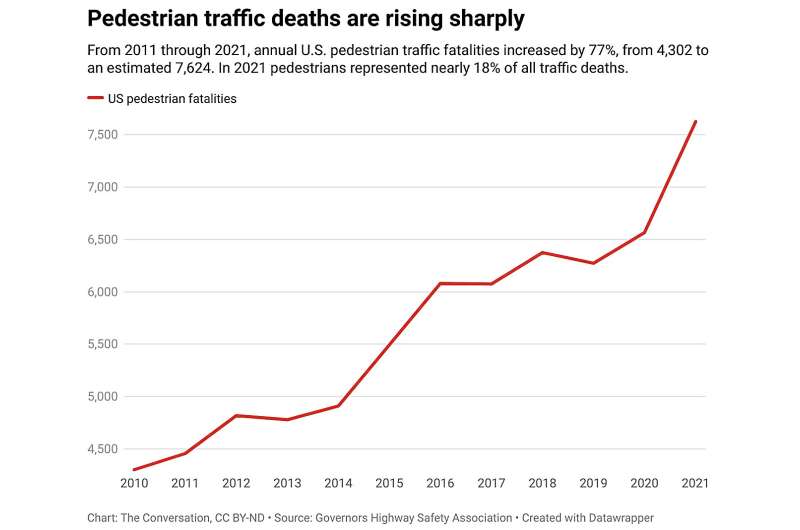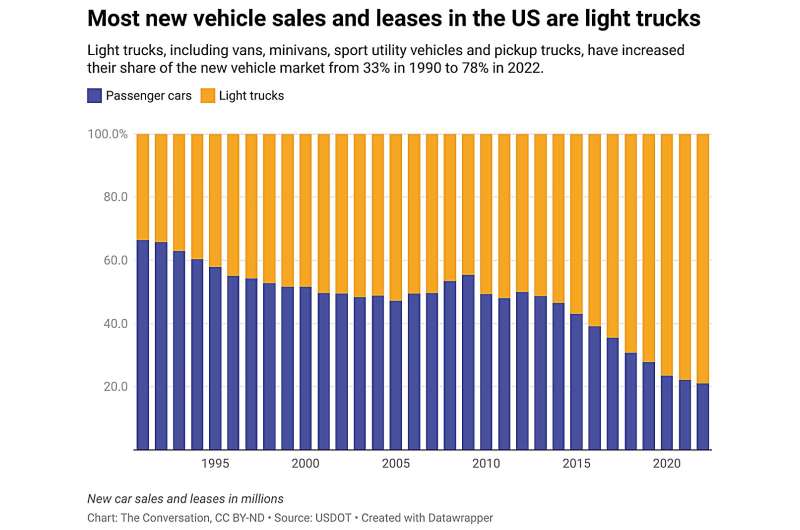
Deadly traffic incidents have declined in most developed countries in recent years. But in the U.S. they’re becoming more common. Deaths in motor vehicle crashes rose more than 33% from 2011 to 2021. Since 2010, pedestrian deaths nationwide have climbed a shocking 77%, compared with a 25% increase in all other types of traffic fatalities.
Light trucks injure pedestrians more severely than passenger cars in crashes, and the size of cars and trucks sold in the U.S. continues to swell. Some current models, such as the Toyota Rav4, are one-third larger than they were 15 years ago.
Based on my experience researching urban planning and street design for the past three decades, I know that U.S. cities are primarily vehicle-centered rather than human-centered. Rules established in the 1920s govern how people use vehicles in public streets, and other governmental controls tell manufacturers how big those vehicles can be.
Today, these sets of rules have created public spaces where it is safer to be inside a vehicle than outside.
The U.S. has not moved as quickly as other countries to prioritize the safety of people outside of cars, especially as cars have grown larger and heavier. As a consequence, Americans are paying the price in lives lost, skyrocketing public health costs and reduced mobility.
Larger, heavier and deadlier
Data clearly shows that since 2008, cars and trucks sold in the U.S. have been continually getting bigger. The Department of Transportation’s corporate average fuel economy standards have constrained overall gasoline consumption but have also led to an increase in vehicle size.

That’s because these standards have two sets of rules: one for cars and a looser set for light trucks. As a result, automakers have built more sport utility vehicles and light trucks, as well as cars designed to meet light truck standards, like the Subaru Outback. For almost a decade, they have increasingly moved away from producing small cars and sedans.
Modern auto showrooms are dominated by sport utility vehicles, minivans and pickup trucks. According to 2022 data from the U.S. Environmental Protection Agency, three-quarters of new vehicles produced in the U.S. are light trucks.
Those large vehicles create severe safety hazards on neighborhood city streets for children or adults who might be walking or cycling. Because these vehicles are taller, they are more likely to strike people at higher points and produce head or neck injuries rather than leg injuries. Their larger frames worsen visibility for drivers, especially when a vehicle is turning.
As a result, transport agencies, journalists and public safety advocates are increasingly identifying large vehicles as a significant impediment to creating communities with safer streets.
A slow federal response
Until now, the U.S. has not enacted regulations that require car manufacturers to consider the safety of anyone outside of cars. Now, however, the National Highway Traffic Safety Administration is proposing to add information to its crash test ratings measuring how well cars protect pedestrians in crashes. For example, bumpers and hoods could be redesigned to bend more easily and absorb more energy if a vehicle strikes a person.
But as currently proposed, pedestrian safety would not be factored into the overall five-star safety rating. A vehicle could receive a failing grade for protecting pedestrians yet still earn a five-star safety rating overall.
People deserve to safely travel on public streets and in parking lots. In my view, the quickest and most effective way to tackle car bloat is to transform social expectations for the shape and size of vehicles. Several European cities show how this kind of shift can happen.
A time for local action
Amsterdam and Copenhagen are widely viewed as models for using public space in ways that prioritize people—but they weren’t always that way. Starting in the 1970s, grassroots movements in both cities pressed officials to reduce the dominance of cars and make streets safer for the public. These movements initially were slow to catch on but gained support over time.
Today, similar initiatives are moving forward in cities across France and Germany. Even traditionally car-centric European cities, such as Brussels and Ghent, are increasingly adopting human-focused policies by designating where cars, especially large cars, can and cannot travel.
As a visiting professor in the Netherlands, a Fulbright scholar to Italy and a lecturer across Germany and Poland, I have seen the benefits of these initiatives close at hand. I’ve also learned that it will require public action to create support for such changes in the U.S.
The goal is to modify the design of neighborhood streets and parking areas in ways that prioritize pedestrians, bicycles and new forms of personal transport like microcars. Federal survey data shows that nearly half of trips that Americans drive are shorter than four miles (6.5 kilometers). Ideally, people can be discouraged from using large passenger vehicles for most of this type of travel.
What communities can do
Streets and roads are local public spaces. Therefore, local officials and citizens have important roles to play in mitigating escalating car size in their community.
Some policymakers are proposing to rein in large vehicles through tax policies, such as weight-based registration fees. But measures like this won’t avert the emerging safety crisis in the near term. Rather, I believe this kind of broad cultural shift requires collective action, starting at the local level with street design reform.
In my view, communities seeking to discourage the predominance of oversize vehicles and encourage use of smaller, lighter and slower vehicles could consider taking such steps as:
- Creating prioritized parking spaces closer to stores for all forms of mobility that are narrow or less than 8 feet (2.5 meters) long.
- Using posts or bollards, which can be removable, to limit vehicle access to commercial areas and neighborhoods where pedestrians, bikes and smaller cars get priority.
- Radically narrowing travel lanes on streets to force traffic to slow down and free up space for wider sidewalks and bike lanes.
- Limiting or ending vehicle access to streets near schools and economically vibrant commercial districts, either permanently or at high-use times of day.
How would such steps make people safer? Ask communities around Boston, which have cut several accident-prone four-lane roads down to two lanes each, reducing traffic speeds and crashes and creating more green space. Or those in the Atlanta suburb of Peachtree City, which has used parking lots and street space to augment a network of more than 100 miles (160 kilometers) of paved paths for walkers, bikers and registered golf carts.
Repurposing space in streets and parking areas requires city governments and residents to emphasize the public right of way and view street space as a place to devise solutions. There is ample evidence that doing so will make U.S. communities safer.
This article is republished from The Conversation under a Creative Commons license. Read the original article.![]()
Citation:
Ever-larger cars and trucks are causing a safety crisis on US streets. How communities can fight back (2023, August 3)
retrieved 5 August 2023
from https://techxplore.com/news/2023-08-ever-larger-cars-trucks-safety-crisis.html
This document is subject to copyright. Apart from any fair dealing for the purpose of private study or research, no
part may be reproduced without the written permission. The content is provided for information purposes only.
Stay connected with us on social media platform for instant update click here to join our Twitter, & Facebook
We are now on Telegram. Click here to join our channel (@TechiUpdate) and stay updated with the latest Technology headlines.
For all the latest Technology News Click Here
For the latest news and updates, follow us on Google News.
